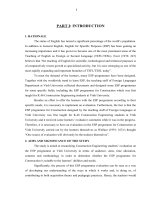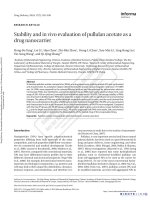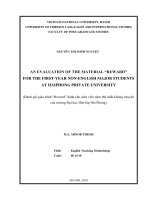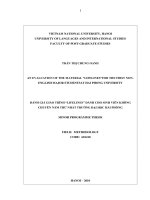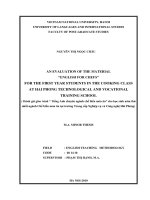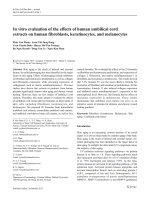Truong Quang Hai IVIDES Evaluation of the geological heritage DR DR
Bạn đang xem bản rút gọn của tài liệu. Xem và tải ngay bản đầy đủ của tài liệu tại đây (1.01 MB, 9 trang )
Geoheritage
DOI 10.1007/s12371-016-0176-1
ORIGINAL ARTICLE
Evaluation of the geological heritage of the Dray Nur and Dray
Sap waterfalls in the Central Highlands of Vietnam
Ta Hoa Phuong 1 & Nguyen-Thuy Duong 1 & Truong Quang Hai 1 & Bui Van Dong 1
Received: 2 August 2015 / Accepted: 3 March 2016
# The European Association for Conservation of the Geological Heritage 2016
Abstract The Central Highlands in Vietnam are well known
for their large basalt plateau and their natural touristic resources with impressive landforms, such as ancient volcanoes,
lakes and waterfalls, which are the result of volcanic activities,
and of which the waterfalls are especially spectacular scenically. The Dray Nur and Dray Sap waterfalls located on the
Serepok River of Dak Lak and Dak Nong provinces, respectively, are remarkable landscapes with a significant aesthetic
value. Not only are these waterfalls well known as tourist
attractions, they are also noted for a system of impressive
geological objects, including basalt columns beneath torrential
waterfalls, contemporaneous columnar and pillow basalts,
fan-shaped columnar structures, collapsed wells, cliffs formed
at the base of basalt columns, and the boundary between columnar basalts and Jurassic sediments. The aim of the study
reported here is to demonstrate the relevance of this site as a
geomorphological and geological heritage site, according to
current inventory and evaluation methods. The results show
that the Dray Nur and Dray Sap waterfalls include 10
inventoried geo-points, relevant to four key themes, namely
science, culture, education and tourism. The ultimate goal of
the study is to use these results as justifications for the conservation of the area.
Keywords Vietnam . Geosite . Columnar basalt . Jurassic .
Waterfall . Natural environment
* Ta Hoa Phuong
1
VNU University of Science (HUS), 334 Nguyễn Trãi Street,
Hanoi, Vietnam
Introduction
Geological heritage sites with outstanding values for science,
education, aesthetics and economics are regarded as special
natural resources (Gray 2004). They consist of special geological and geomorphological sites with rocks, minerals, fossils,
soils, landform and landscapes that are both the products and
records of the evolution of the planet Earth and, as such, form
an integral part of the natural world (Eder and Patzak 2004).
Geological heritage, a type of nonrenewable resources, therefore, should be protected, conserved and sustainably used.
A system of criteria that concern the evaluation of the
geoheritage has been proposed and related to different values
such as intrinsic, cultural, aesthetic, economic, research, educational and functional (Gray 2004). However, the value of
the geoheritage sites depends on geological objects, which can
be used for evaluation purposes through an open system of
qualification. Geological objects may present different contents that display heritage values and depend on the meaning
of their attributes. As pointed out by Carreras and Druguet
(1998), ‘the diversity of contents and the different protection
criteria leads to the existence of a great variety of legal regulations’. Thus, geological heritage should be protected all over
the world, as its objects with different contents may be or not
at risk, depending on a wide range of factors, most of them not
related with its contents.
Vietnam possesses many beautiful natural landscapes
that show a great potential as natural heritages. Since
the 1990s, UNESCO has listed a number of natural
World Heritage sites, such as Ha Long Bay (designated
in 1994 and 2000), Phong Nha-Ke Bang National Park
(designated in 2003), Trang An Landscape Complex
(designated in 2014) and Dong Van Karst Plateau
Global Geopark (designated in 2009) (Fig. 1a).
However, many other geological sites of potential
Geoheritage
Fig. 1 a Map of Vietnam with
natural heritages that have been
recognised by UNESCO and
basalt centres; b Buon Ma Thuot
area; c Location of the Dray Nur
and Dray Sap waterfalls
heritage value have not yet been defined and recognised
in Vietnam.
The Central Highlands, part of South Central Vietnam,
have a number of beautiful natural sceneries, such as relatively
untouched forests, waterfalls and spectacular views, in contrast to other areas still scarred by twentieth century war. The
Central Highlands is a huge basalt plateau formed during periods of powerful volcanic activity from the Neogene to the
Quaternary. Consequently, impressive landforms, such as ancient volcanoes, lakes and waterfalls, formed by volcanic activities have created the typical landscapes in the Central
Highlands. However, no systematic geosite inventory has
been carried out in this area.
The goal of this present study is to carry out an inventory of
the site features in the Dray Nur and Dray Sap waterfalls and
then evaluate them within the framework of a potential geological heritage site in order to support the definition of
geoconservation strategies.
The Study Area
The Serepok River in the Central Highlands is at the confluence of two tributary rivers, named the Krong Ana and Krong
No, meaning female and male, respectively, in Ede ethnic
language. When it flows towards the boundary between the
Dak Lak and Dak Nong provinces, the Serepok River divides
into two branches, flows down the Dray Nur and Dray Sap
waterfalls, and is then joined together again to the north
(Fig. 1c). The Dray Nur and Dray Sap waterfalls, which are
Geoheritage
considered as the most majestic waterfalls in the Central
Highlands, are located about 25 km to the southwest of
Buon Ma Thuot city, along the national highway (NR) 14
(Fig. 1b). Although these waterfalls are situated in two different provinces, they are quite close together and jointed by two
suspension bridges and a short walkway.
The Dray Nur and Dray Sap are impressive waterfalls with
similar sizes, spanning a width of ca. 150 m, a height of ca.
30 m and a length of ca. 250 m. The wall of water plunging
down to the basalt columns creates an impressive natural marvel (Figs. 2f and 3f). The interference of the white water and
the dark basalt rocks, whose structure is columnar and diversely oriented, creates an unsteady feeling. The water falling from
the top of a giant basalt column wall represents one of the
most rare and spectacular landscapes, not only in Vietnam
but also worldwide. Behind an amazing veil of mist, like a
mirror of smoke, there are several small caves in the deep cliff
at the bottom of columnar basalts created by undercutting of
the cliff, but hidden behind the waterfalls (Fig. 2b, g). Looking
out from the caves is a spectacular scene composed of
looming shadows of trees, with tottering blocks of rocks
displayed through long water walls.
The Dray Nur and Dray Sap waterfalls have become attractive tourist destinations (Fig. 2g, h), with pronounced hanging
basalt columns beneath a ca. 30-m-high waterfall. The basalt
columns were generated under geological conditions which
affected their aspect, petrology and structure. The basalt
cooled rapidly from the outside towards the centre, causing
shrinkage cracks to form either a hexagonal pattern or sometimes 3- or 12-sided shapes. The shape of the columns is
attributed to tensional stress (Bates and Jackson 1984).
The combination of basalt columns and a waterfall is not
unique in the world, but the basaltic rocks in the Dray Nur and
Dray Sap waterfalls are regarded as an original feature, because of the presence of geological objects related to basalt
magmatism, such as columnar basalt and pillow basalt together in one place, as well as fan-shaped columnar structure,
collapsed wells, cliff undercutting in the bottom of basalt columns and the boundary between columnar basalts and
Jurassic sediments. In addition, these waterfalls are quite close
together and connected by two suspension bridges (Fig. 3a, c)
and are ranked among the top scenic geotopes in the Central
Highlands of Vietnam.
extensional rifts (Barr and MacDonald 1981; Whitford-Stark
1987). The basaltic centres in Vietnam occupy an area of ca.
23,000 km2, mainly distributing in Phuoc Long, theCentral
Highlands and the North (Hoang et al. 1996; Hoang and
Flower 1998; Bat et al. 2002; Fedorov and Koloskov 2005).
For most of the volcanic centres, there are two eruptive
episodes including (1) an early series formed by high SiO2,
low FeO* quartz and olivine tholeiites that are large melt
fractions of refractory (lithosphere-like) mantle, and (2) a later
series made up of low SiO2, high FeO* olivine tholeiites,
alkaline basalts and basanites that are smaller melt fractions
of more fertile (asthenosphere-like) mantle (Hoang and
Flower 1998). The basalt rocks in the Dray Nur and Dray
Sap waterfalls belong to Buon Ma Thuot centre, one of five
basaltic centres in the Central Highlands.
The Buon Ma Thuot plateau occupies an area of about
3800 km2 in the largest basaltic plateaus in the Central
Highlands of ca. 14,500 km2 (Hoang et al. 1996; Hoang
and Flower 1998; Bat et al. 2002). While still reflecting
two major phases, their eruptive stratigraphy differs significantly from that recorded in most of the centres. The
early phase of Buon Ma Thuot activity was dominated
by alkali basalts, which are succeeded (mainly) by olivine tholeiites that were dated at 8.7–4 Ma. Both alkaline
basalts and tholeiites in this phase vary from aphyric to
olivine and augite phyric, and generally lack plagioclase
phenocrysts. The later phase, in the upper part, has been
dated at <2–0.3 Ma and consists of alkali basaltic flow
intercalated with thin flows of olivine and quartz (rare)
tholeiites, all, except for the tholeiites, showing prominent olivine microlites in the groundmass (Hoang et al.
1996; Hoang and Flower 1998). According to Hoang
et al. (2013), the basaltic plateau in Buon Ma Thuot
was generated in the regional post extrusion stress field,
thus, potentially resulting in the columnar basalts in the
Dray Nur and Dray Sap waterfalls.
The columnar basalts in the research area were formed
during the later eruptive phase by alkali basalts and olivine
tholeiites. Their chemical compositions, analysed by XRF,
show SiO2 contents ranging 44.87–53.16 wt%, 10.69–
11.50 wt% of FeO* content and 1.77–2.46 wt% of TiO2.
Methods
Geological Setting
Inventory
Although the Dray Nur and Dray Sap waterfalls are famous
primarily for their extraordinary natural beauty, they also provided geological data on the history of the Earth’s crust during
the Neogene-Quaternary periods. Over this interval, intraplate
volcanism was widespread in East and Southeast Asia,
forming basalt plateaus associated with pull-apart and
The inventory method is a tool used to list the heritage
assets, recognise their value and subsequently promote
them. Singular and/or monumental features are attributes
that one tries to identify in each inventoried asset in
order to enhance its value and justify its protection
(Reis and Henriques 2009). The method that was used
Geoheritage
Fig. 2 Characterised heritage
sites with geomorphological and
geological values. a Collapsed
well in basalt columns, b, c fanshaped structure in basalt
columns and undercutting in the
bottom of basalt columns, d basalt
columns as seen from straight
above, e boundary between
columnar basalt and Jurassic
sediments, f, g general view of the
Dray Nur waterfall and g
undercutting in the bottom of the
basalt columns
for the Dray Nur and Dray Sap waterfalls is based on (1)
the International Scientific Committee on Cultural
Landscapes of International Council on Monuments and
Sites (ICOMOS), Cultural Landscape inventory sheet
proposal ( />card.htm), and (2) the International Union for the
Conservation of Nature (IUCN) ( />d o w n l o a d s / g e o l o g y. p d f ) , g l o b a l f r a m e w o r k f o r
Geological World Heritage which has advanced the
characterisation of the typology associated with
geological heritage, as used in several countries to
inventory and evaluate geological and geomorphological
sites (Dingwall et al. 2005).
The geosite identification should follow the definition of
geological framework and be adapted to the local reality.
There are three simple criteria generally selected in each
framework including representativeness, scientific relevance
and integrity (Lima et al. 2010). For the work reported here,
inventoried structures and proposals were followed, with a
typology considering several criteria, such as geomorphological, geochemical, geophysical, geological history,
palaeontology and/or palaeobiological, pedological,
Geoheritage
Fig. 3 Characterised heritage
sites with geomorphological and
geological values (continued). a,
c Two suspension bridges
connecting the Dray Nur and
Dray Sap waterfalls together; b
bedding structure of Jurassic
sediments of La Nga Formation
occurring in the Serepok River; d,
e columnar basalt and pillow
basalt boundary; f general view of
the Dray Sap waterfall
palaeoclimatic, impact crater, marine, submarine,
metalogenetic, metamorphic, sedimentary and igneous,
among others.
Evaluation
Geomorphological and geological characterisations are
enough to achieve the aim expressed for the inventory of a
geosite. But, as this geosite is a truly geological heritage site, it
is convenient to enlarge the characterisation and include the
assessment of its potential use. According to Brilha et al.
(2005), the geological heritage of geosites may contain one
or more geodiversity element of exceptional scientific, educational, cultural, touristic or other value. The attribution of the
value to these sites would be able to demonstrate their possible
or effective utilisation. Thus, it is necessary to have both a
large body of scientific knowledge on the site and a selection
of elements to attribute value, so that one can evaluate each
geosite objectively, with little or no subjectivity.
This research has used three criteria, including science,
education and tourism, to select representative geosites in
the Dray Nur and Dray Sap waterfalls. A scientific criterion
is exhibited by three sub-criteria of representativeness, singularity and proximity. Here, the representativeness sub-criterion
is related to the appropriateness of the geosite to illustrate a
geological process that brings a meaningful contribution to
understand a geological topic, process or feature; the singularity sub-criterion regards the number of similar occurrences of
a geological process or feature on a specific area; the proximity sub-criterion considers the possibility of having different
relevant geological processes or features that might be integrated in the same geosite. The educational and touristic
criteria that follow the proposed evaluation system from
Rocha et al. (2013) and Reis and Henriques (2009) were used
for values or contents displayed by geological objects.
The evaluation system of Rocha et al. (2013) selects criteria
for the potential of education and tourism and evaluates them
by comparative ranking system in a scale of one to five points
according to Braga (2002).
Reis and Henriques’s (2009) method does not use a quantitative ranking system. The method is a simple and objective
way to visually show the qualitative relevance of the
Geoheritage
geological heritage basing on an integrated approach of the
two variables previously described: relevance grade and abstract perceptiveness. There are four ranks of content value
including rank I, represented by indicial contents; rank II,
displayed by documental, iconographic, and symbolic contents; rank III, exhibited by conceptual and scenic contents;
and rank IV, referring to universal content.
–
–
Stratigraphical, due to boundary between columnar basalts and Jurassic sediments of the La Nga Formation
(geo-point 4; Fig. 2e)
Hydrogeological, due to the accumulation of freshwater
in the Serepok River, supplying water resource to waterfalls and hydroelectric dam about 4 km away from the
falls (geo-point 7; Fig. 3b)
Cataloging Data
According to the inventory method established by Lima et al.
(2010), ICOMOS and IUCN, 10 geo-points within the Dray
Nur and Dray Sap waterfalls have been established (Fig. 4)
and correspond to the following types of heritage:
–
–
–
–
Geomorphological, due to the scenic beauty of the impressive waterfalls cascading over basalt columns (geopoint 5, Fig. 2f, h; and geo-point 10, Fig. 3f) and of the
two suspension bridges connecting Dray Nur and Dray
Sap waterfalls (geo-point 6 and 8; Fig. 3a, c)
Petrological, due to the occurrence of basalt columns beneath the torrential waterfalls (geo-points 3, 4 and 5;
Fig. 2d–g); contemporaneous columnar basalts with pillow basalts (geo-point 9; Fig. 3d, e)
Tectonic, due to the appearance of fan-shaped columnar
structure (geo-point 2; Fig. 2b, c), collapsed well in the
cluster of basalt columns (geo-point 1; Fig. 2a), and cliff
undercutting in the bottom of the basalt columns (geopoint 2, 5 and 10; Fig. 2b, g)
Sedimentary, due to bedding structure of the Jurassic La
Nga Formation exposed in the bottom of Serepok River
(geo-point 7; Fig. 3b)
Fig. 4 Location of the geo-points
in the Dray Nur and Dray Sap
waterfalls. (1) collapsed well in
basalt columns; (2) fan-shaped
structure in basalt columns; (3)
basalt columns as seen from
straight above; (4) boundary
between columnar basalt and
Jurassic sediments; (5) Dray Nur
waterfall; (6) bridge in the Dray
Nur waterfall; (7) bedding
structure of the Jurassic sediments
of the La Nga Formation; (8)
bridge in the Dray Sap waterfall;
(9) columnar basalt and pillow
basalt boundary and (10) Dray
Sap waterfall
Assessment
Although Dray Nur and Dray Sap waterfalls are the famous
sites in the Central Highlands, which is also well known for
the vast scientific documentation concerning the large regions
of ‘diffuse basalt eruptions’ (Hoang and Flower 1998), they
have not been the subject of a systematic inventory of
geosites.
The scientific relevance of the Dray Nur and Dray Sap
waterfall was well demonstrated in the geological setting section and as such the scientific use for these waterfalls is quite
clear. However, their potential educational and touristic uses
need to be assessed. The combined criteria to analyse and
assess their potential use in education and tourism are presented in Table 1 and were selected from the open system proposed by Rocha et al. (2013).
To assess the potential for educational use, we have selected six of the seven criteria, such as accessibility, associated
resources, viewing conditions, educational content, fragility
and representativeness. These criteria were evaluated on the
basis of a scale of one to five points, proposed by Braga
(2002), and used by Rocha et al. (2013). The significance of
Geoheritage
Table 1
Assessment of potential use for education and tourism of the Dray Nur and Dray Sap waterfalls according to Rocha et al. (2013)
Criteria for potential educational and touristic uses
Point Description and assessment for the waterfalls
Point
(1) Accessibility (Ac) criterion (possibility to easily reach the geosites)
Direct access by municipal/national road
Direct access by a pathway or a paved road
5
4
Direct access by a pathway or a non-paved road
Less then a 1 km distance from any pathway
3
2
More then a 1 km distance from any pathway
1
(2) Association with other resources (Ar) criterion
Association with other features up to 500 m distance
Association with other features up to 1000 m distance
No associated features
The waterfalls are located along national highway (NR) 14 and distant 5
about 1.5 km from provincial road (PR) 684 and could be directly
accessed by bus on asphalted road.
5
3
1
The waterfalls include two independent Dray Nur and Dray Sap
3
waterfalls with distance of approximately 0.5 km. A convenient
way to travel from one to another is two suspension bridges and
paved road of columnar basalt. There are other smaller waterfalls
named Gia Long and Buon Kuop hydroelectric lake that is located
about 4 km to the west of these waterfalls.
5
5
The geological objects, such as basalt columns beneath torrential
waterfalls, contemporaneous columnar and pillow basalts, fanshaped column structure, collapsed well, cliff undercutting in the
bottom of basalt columns and boundary between columnar basalts
and Jurassic sediments, are regarded as examples of educational
contents to any teaching level and to the general public.
(3) Educational content (Edu) criterion
Clearly exemplifies educational contents to any teaching
level and to the general public
Clearly exemplifies educational contents to any teaching
grade
Clearly exemplifies educational contents for graduate and
post-graduate studies
(4) Spectacularly (Spe) criterion
Used for national tourism iconography
Used for local tourism iconography
Not used for tourism iconography
4
3
5
3
1
The Dray Nur and Dray Sap waterfalls are regarded as typical
prospects of the Central Highlands of Vietnam because of
marvelous water flows and imposing wall of columnar basalts.
3
(5) Fragility (Fra) criterion (linked to the negative impacts of anthropogenic activities)
3
Decametric dimension sites hardly affected by anthropogenic 5
The water resource coming to these waterfalls could be effected in
activities
disadvantage by developing more hydroelectric dams on the
Decametric to metric dimension sites moderately affected by 3
Serepok River.
anthropogenic activities
Metric dimension sites easily affected by any anthropogenic 1
activity
(6) Viewing conditions (Vie) criterion (presents the quality of the geosite visualisation)
Exceptional viewing conditions (to the fullest extent and
5
The viewing conditions are in the full extent of the geosites with the 5
easily observable)
opportunities to directly observe and study all geological objects.
Good viewing conditions (to the fullest extent but with some 4
difficulty)
Median viewing conditions (not observable in the fullest
3
extent)
(7) Representativeness (Rpr) criterion
Best example in Vietnam of a geological process or feature 5
This is the best example in Vietnam of geological process of basaltic 5
Best example in the Central Highlands of a geological
4
magmatism.
process or feature
Representative of various geological contexts
3
the criteria is to provide clear evidence of the educational
relevance of these waterfalls for geological education, when
used as an educational resource according to activities integrated in a curriculum (Henriques et al. 2012).
The assessment of the potential touristic use is based on
five criteria, including accessibility, associated resources, educational content, fragility and scenery. The presence of spectacular scenic aspects is commonly regarded as the first suggestion of the geotouritic potential of a geosite, once landscapes are at the top of the hierarchy of the features of
geotouristic interest (Newsome and Dowling 2006). The
‘spectacularity’ criterion that is of significant importance for
evaluating the touristic potential is assessed on the basis of the
actual use of a geosite as an icon in tourism strategies, campaigns and documents (Braga 2002, as exemplified in the
research of Rocha et al. 2013). However, the Dray Nur and
Dray Sap waterfalls have not yet been established as a geosite
and for geodiversity conservation. According to Gray (2008)
geodiversity can be used as a basis for the development of
geotourism activities. So, in order to promote the use of the
Geoheritage
Fig. 5 Evaluation system for the
contents of the Dray Nur-Dray
Sap waterfalls (according to Reis
and Henriques 2009)
waterfall’s geosites and geodiversity, several resources, such
as a geosites map, textbook and informative panel, need to be
developed and addressed to the general public, schools or
universities.
According to Reis and Henriques (2009), the Dray Nur and
Dray Sap waterfalls would score as Rank III, because of their
regional importance and the material, iconographic, symbolic,
documental and scenic types of abstract perception. They are
positioned between vectors 1 and 3 in the graph, i.e., between
that of social influence and that integrated with scientific influence (Fig. 5).
The geological objects that correspond to a local scale content exhibiting a clear relationship between elementary geological processes and their resulting products, and specialised
knowledge of particular geological phenomena, are generally
regarded as indicial and iconographic contents (Reis and
Henriques 2009). The presence of two basalt types (column
and pillow) (Fig. 3d), collapse structures (Fig. 2a, b, g) and
bedding structure of sedimentary rock (La Nga Formation)
(Fig. 3b), suggests their process of formation and origin in
an obvious way. These contents are particularly relevant for
illustrating the detailed features of geological systems in the
past and can be used as illustrations in scientific publications.
The Dray Nur and Dray Sap waterfalls are widely known to
the public as famous tourist attractions for their dramatic beauty rather than their valuable geological features. These sites
are impressive outcrops where significant geological features
are exhibited, but the remarkable features that contribute to
attract people are the high value of the scenery and legends
associated with the Serepok River. These are now a symbol of
the Central Highlands of Vietnam.
The thorough knowledge of the basalt plateau in the
Central Highlands enriches the documental content. A highly
demonstrative record of the chemical composition and
formation of basalts is particularly relevant for the understanding of the significant geological processes involved in this
area.
The scenic content refers to a landscape value that is of
highly abstract concept, providing a high recreational function
in the Dray Nur and Dray Sap waterfalls. Unusual
geomorphical features reinforce the aesthetic value of this
content (Gray 2004; Brilha et al. 2005); moreover, emergent
natural values, such as amenity, quietness or discovery, tend to
become relevant components as well. According to the Dak
Lak Department of Tourism, Culture, Sport, and Tourism,
around half a million visitors area attracted to these waterfalls
every year.
Conclusions
The method used here to score sites in a ranking system was
conducted using parameters related to scientific, educational
and touristic potentials. The high value attributed to the Dray
Nur and Dray Sap waterfalls by their classification, as a
geomorphosite, should be adequate to show their touristic
importance and reinforces their potential for educational and
cultural use. The reasons of this evaluation are as follows: the
site is of easy access and observation capacity; the diversity of
observable elements; the existence of scenic combinations,
such as majestic waterfalls, basalt columns, the strength and
legends of the Serepok River; and the current touristic use.
Ten geo-points, which were inventoried, related to several
types of heritage and are enough to demonstrate that the Dray
Nur and Dray Sap waterfalls are a geomorphologicalgeological heritage site. Seven criteria, including accessibility,
association with other resources, educational content, spectacular view, fragility, viewing conditions and representativeness,
Geoheritage
were used to identify and characterise their potential educational and touristic uses; these criteria and weightings therefore support their ranking according to their potential uses.
The evaluation of the Dray Nur and Dray waterfalls as a
geological heritage was also assessed by their content of geological objects, plotted on a graph of abstract perceptiveness
versus relevance grade, according to Reis and Henriques’s
(2009) method. The result shows their importance due to their
scenic beauty, landscape representativeness, culture value, and
social and scientific influence, being placed at Rank III, and
outranked by sites of regional importance.
The evaluation results show the necessity of conserving,
protecting and managing geo-points in these waterfalls, both
for their cultural value and their continuing touristic, educational and scientific uses. They can be used to establish priorities for the application of protection measures and to support
the definition of geoconservation strategies.
Acknowledgments This work was supported by the project ‘Research,
comprehensive evaluation on tourist resources and spatial organization
for proposals towards tourism development in the Central Highland of
Vietnam’ (Code: TN3/T18), which is under the key state-level program of
‘Science and technology for socio-economic development in the Central
Highlands of Vietnam’ (Code: KHCN-TN3/11-15). The chemical composition of columnar basalts was analysed by XRF (XRF—1800
Shimadzu) at the Faculty of Geology, VNU University of Science.
References
Barr SM, MacDonald AS (1981) Geochemistry and geochronology of
late Cenozoic basalts of southeast Asia. Geol Soc Am Bull (Part II)
92:1069–1142
Bat DV, Toat DD, Truong V, Tan MT, Thu LT (2002) Correlation and
comparison of Cenozoic effusive magmas in continent and continental shelf of Vietnam. J Geol (Hanoi) 272:9–10(in Vietnamese
with English abstract)
Bates RL, Jackson AJ (1984) Dictionary of geological terms. Doubleday,
New York
Braga JC (2002) Propuesta de estraté gia andaluza para la conservación
de la geodiversidad [Andalucia strategy proposal for the conservation of geodiversity]. In: Junta de Andalucı’a. Medio Ambiente,
Consejerı’a de 105 pp. (in Spanish)
Brilha JB, Andrade C, Azeredo A, Barriga F, Cachao M, Couto H, Cunha
PP, Crispim JA, Dantas P, Duarte LV, Freitas M, Granja HM,
Henriques MH, Henriques P, Lopes L, Madeira J, Matos JMX,
Noronha F, Pais J, Picarra J, Ramalho M, Relvas J, Ribeiro A,
View publication stats
Santos A, Santos V, Terrinha P (2005) Definition of the
Portuguese frameworks with international relevance as an input for
the European geological heritage characterisation. Episodes 28(3):
177–186
Carreras J, Druguet E (1998) The geological heritage of the Cap de Creus
Peninsula (NE Spain): some keys for its conservation. Geologica
Balcanica 28(3–4):43–47
Dingwall P, Weighell T, Badman T (2005) Geological world heritage: a
global framework. In: A contribution to the Global Theme Study of
World Heritage Natural Sites. Protected Area Programme, IUCN
( />Eder W, Patzak M (2004) Geoparks—geological attractions: a tool for
public education, recreation and sustainable economic development.
Episodes 27(3):162–164
Fedorov I, Koloskov AV (2005) Cenozoic volcanism of southeast Asia.
Petrology 13(4):352–380
Gray M (2004) Geodiversity: valuing and conserving abiotic nature. John
Wiley & Sons Ltd, The Atrium, Southern Gate, Chichester, West
Sussex PO19 8SQ, England
Gray M (2008) Geodiversity: developing the paradigm. Proc Geol Assoc
119:287–329
Henriques MH, Tomaz C, Sa AA (2012) The Arouca Geopark (Portugal)
as an educational resource: a study case. Episodes 35(4):481–488
Hoang N, Flower MFJ (1998) Petrogenesis of Cenozoic basalts from
Vietnam: implication for origins of a diffuse igneous province. J
Petrol 39:369–395
Hoang N, Flower MFJ, Carlson RW (1996) Major, trace element, and
isotopic compositions of Vietnamese basalts: interaction of enriched
mobile asthenosphere with the continental lithosphere? Geochim
Cosmochim Acta 60:4329–4351
Hoang N, Flower MFJ, Chi CT, Xuan PT, Quy HV, Son TT (2013)
Collision-induced basalt eruptions at Pleiku and Buon Me Thuot,
south-central Viet Nam. J Geodyn 69:65–83
Worldwide basic inventory/register card for cultural landscapes.
International Council on Monuments and Sites (ICOMOS):
Cultural Landscape inventory sheet proposal (mos.
org/landscapes/inventory_card.htm)
Lima FF, Brilha JB, Salamuni E (2010) Inventorying geological heritage
in large territories: a methodological proposal applied to Brazil.
Geoheritage 2(3–4):91–99
Newsome D, Dowling RK (2006) The scope and nature of geotourism.
In: Dowling RK, Newsome D (eds) Geotourism. Elsevier,
Amsterdam, pp. 3–25
Reis RP, Henriques MH (2009) Approaching an integrated qualification
and evaluation system of the geological heritage. Geoheritage 1:1–
10
Rocha J, Brilha J, Henriques MH (2013) Assessment of the geological
heritage of Cape Mondego Natural Monument (Central Portugal).
Proc Geol Assoc. doi:10.1016/j.pgeola.2013.04.005
JL Whitford-Stark (1987) A survey of Cenozoic volcanism on mainland
Asia. Geological Society of America, Special Papers 213, 74 pp

